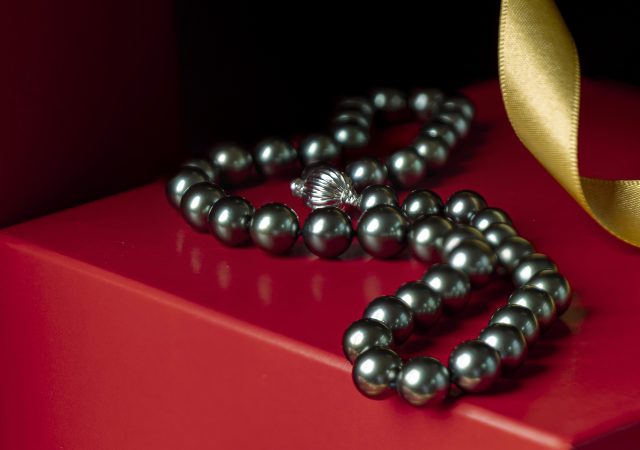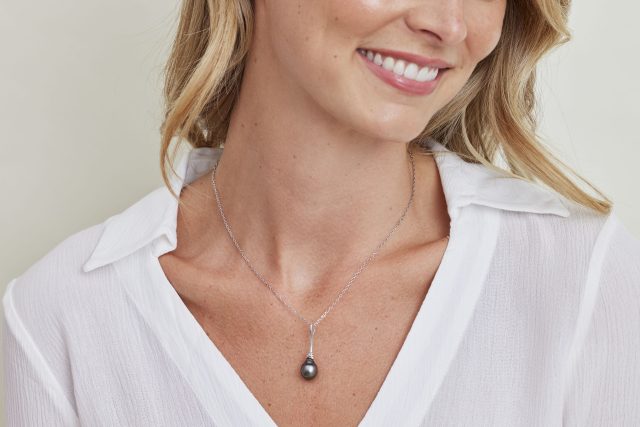Tahitian pearls, often hailed as the ‘queen of pearls,’ are a worldwide sensation due to their unique allure and impressive luster. As the only naturally dark pearls, they exude an aura of mystery and sophistication. While their appeal is undeniable, it is the fascinating cultivation process of these Tahitian pearls that genuinely enriches their value.
Sourced from the black-lipped oyster, or Pinctada margaritifera, primarily located in French Polynesia, Tahitian pearls are not strictly from Tahiti but are collected from numerous islands within the region. Despite this geographical discrepancy, the term “Tahitian pearls” has held firm.
Unlike freshwater and Akoya variants, Tahitian pearls possess a natural dark hue. Their color spectrum ranges from a captivating metallic silver to the depth of graphite, often infused with overtones of green, pink, blue, and yellow. Moreover, their size, with an average diameter spanning 8-16 millimeters, places them significantly larger than other types of pearls.
Every Tahitian pearl starts its journey through a careful and intricate grafting process. A tiny piece of mantle tissue along with a mother-of-pearl bead from a donor oyster is skillfully implanted into a host oyster. This foreign insertion initiates a defense mechanism in the host, compelling it to secrete nacre, the iridescent substance forming the layers of the pearl.
This stage of pearl formation demands utmost patience and consistent care. The host oysters, now carrying the implanted nuclei, are placed in pearl nets and suspended in the tranquil lagoon waters for 18-24 months. This lengthy period enables the oysters to envelop the nucleus with multiple layers of nacre, ultimately leading to the formation of sizable, lustrous pearls.
The culmination of the cultivation process is the momentous harvest. During this delicate operation, pearls are carefully extracted from their oyster homes. Each harvested pearl is meticulously assessed based on various quality factors, including size, shape, color, luster, and surface quality.

The stunning Tahitian pearl colors and their famous iridescence makes these gems a prime choice for diverse jewelry pieces. Whether incorporated in earrings, necklaces, bracelets, or rings, these pearls add an unrivaled elegance that elevates the wearer’s aesthetic charm.
Cultured Tahitian pearls, the true unprocessed gems of the sea, behold an irrefutable allure. Their intricate cultivation process further adds to their appeal, presenting them as a testament to human creativity and the marvel of nature. Hence, owning a piece of Tahitian pearl jewelry transcends the mere acquisition of an accessory—it signifies the embrace of a fragment of the ocean’s hidden magic.

Explore the timeless charm of Tahitian Pearl Pendants. Adorn yourself with nature’s finest pearls, meticulously selected for their unique allure and captivating hues. Elevate your style with our range of classic and contemporary designs, or present the gift of iridescence to a loved one.
Tahitian pearls, often referred to as “black pearls,” stand out for their naturally dark colors. These captivating colors can range from metallic silver to graphite, offering a unique allure. Moreover, Tahitian pearls are typically larger than many other types of pearls, with sizes varying between 8 and 16 millimeters on average.
Tahitian pearls are grown through a delicate process known as grafting. This involves inserting a small piece of mantle tissue and a mother-of-pearl bead from a donor oyster into a host oyster. This stimulates the host oyster to secrete nacre, a lustrous substance that envelops the foreign object and gradually forms the pearl. The entire cultivation period usually spans from 18 to 24 months.
Tahitian pearl value is gauged by factors such as size, shape, color, luster, and surface quality. Pearls that are larger, more round, display deep and vibrant colors, have a high luster, and exhibit a smooth surface are usually considered of higher quality. However, individual preference can also play a significant role in determining the value of a Tahitian pearl.
Signup now and receive an email once I publish new content.